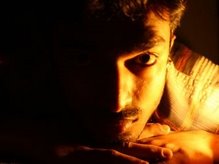When our brain is not sure of what is being sensed it tries to use knowledge to come to a conclusion. When there is some audio playing with a lot of foreground noise your brain will find it difficult to recognize it only till it uncovers the language in which the background audio is playing. If the language is the one it knows it decodes it else everything will be noise. When it comes to illusions also you can tune your brain to recognize the image in certain way only and not the others. I guess one of the things that might have happened to your friend is this. The other is in the way he might have seen the image. I have clearly mentioned in the footer of the image that this applies only when the image is viewed as cross stereo. I will rule out the later case as even you tend to see it either way.
Sense is something that is fuzzy in humans; you know something is hot but cannot tell its exact temperature, you know something is farther away from the other but cannot tell the exact distance between the two, you know some sound is louder than the other but not by how much, etc… So long as you are interested in only the relative information our brain performs exactly but if you question its exactness it becomes relative and fuzzy.
Let me explain relative information taking the top view of the scenario as shown below.
Sense is something that is fuzzy in humans; you know something is hot but cannot tell its exact temperature, you know something is farther away from the other but cannot tell the exact distance between the two, you know some sound is louder than the other but not by how much, etc… So long as you are interested in only the relative information our brain performs exactly but if you question its exactness it becomes relative and fuzzy.
Let me explain relative information taking the top view of the scenario as shown below.
 Currently the objects are placed one beside the other (images not to scale). The relative depth between them will be zero as the distance between the objects in both the eyes will be the same. To observe relative depth between them we will have to first create physical depth between the two by pushing either one of them back.
Currently the objects are placed one beside the other (images not to scale). The relative depth between them will be zero as the distance between the objects in both the eyes will be the same. To observe relative depth between them we will have to first create physical depth between the two by pushing either one of them back. CASE 1: Let me push the rectangle back initially as shown below. ‘L’ and ‘R’ are the projected distances between the objects on the left and the right eye respectively. Whenever the object on the right is in front compared to the one on the left, the projected distance on the left eye will be greater than that on the right.
 CASE 2: Now consider the image below in which the circle is pushed back. For our brain to perceive this physical relative depth the projected distance on the right eye has to greater than that on the left.
CASE 2: Now consider the image below in which the circle is pushed back. For our brain to perceive this physical relative depth the projected distance on the right eye has to greater than that on the left. Let me bring into picture the image that actually created this doubt. If you cross view this stereogram the 2D distance between the objects that the left eye would perceive will be greater than that on the right which is CASE 1.
Let me bring into picture the image that actually created this doubt. If you cross view this stereogram the 2D distance between the objects that the left eye would perceive will be greater than that on the right which is CASE 1.












